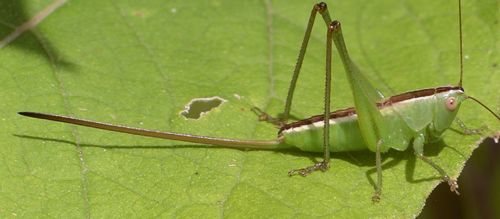
female Straight-lanced Meadow Katydid
Not only are insects very different from us, but they are different in ways that most people have never even heard of. Body parts are not necessarily where you would expect them. For example, a katydid has ears on its front legs and butterflies taste with their feet. Antennae are one of the more familiar arthropod accessories. From fern-like sifters of airborne pheromone molecules carried by male moths to long hair-thin feelers that allow cave crickets to sense their subterranean surroundings, antennae are powerful sensory tools.
Even the most entomologically illiterate folks can identify a few of the aspects that make insects so weird. Compound eyes that practically encircle the entire head, large colorful wings, multi-jointed legs that can jump, run on the ceiling or skate across water, and tubular proboscises that probe flowers for nectar are all features that are easily recognized and associated with insects. But there are other strange and less well known bug bits. Here are five of my favorites.
 female Straight-lanced Meadow Katydid |
Ovipositor
Any insect that has a long pointy thing sticking out of its rear end is usually fairly safe to handle. In spite of the menacing look (think sword, pin or spear) of most ovipositors, their purpose is not to inject venom but to insert eggs into an appropriate habitat so the next generation can carry on. This usually means a plant, the soil, or an unfortunate host such as a caterpillar. Only female insects have ovipositors because only females lay eggs. An ovipositor is not a stinger, but the latter did evolve from the former (and this is why only female insects can sting). True stingers are kept inside the body until needed, and then they are used for defense or to paralyze prey. Insects with notable ovipositors include katydids, crickets, and ichneumons.
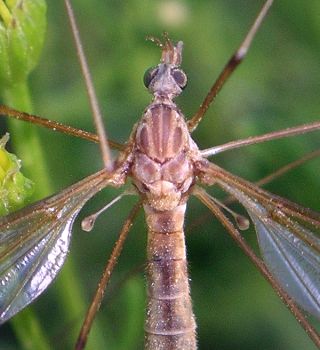 Crane Fly |
Halteres
The basic body plan of an insect includes six legs and four wings. There are, as might be expected in the enormous scope of insects, variations. In one order, Diptera, or the true flies, the second pair of wings has become modified into little club-shaped projections that are organs of balance. As the fly beats its wings, the halteres also move, but not in sync with the wings. The knob at the end of the stem is heavy enough to stabilize the organ, causing it to gyrate mostly in one plane. When the insect changes direction in flight, the haltere twists and the sensory cells on the stem relay information to the nervous system. Anyone who has tried to swat a pesky fly knows full well that they are highly maneuverable and very quick to react. Although a few other insects, such as some mayflies and male scale insects, also have halteres, these structures are easiest to see on large flies with slender bodies, such as crane flies.
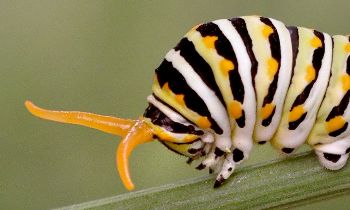 Black Swallowtail caterpillar |
Osmeterium
The caterpillars of one family of butterflies, the swallowtails, have a unique defense mechanism not found in other lepidoptera larvae. The osmeterium is an eversible two-pronged pouch usually kept inside the body, right behind the top of the head. If the caterpillar is touched, it will force the pouch to extend inside out, forming what looks like a forked horn. This organ is usually orange colored, an aposematic warning of the moist toxic chemicals that are exposed. My impression of the smell is that it is sort of sickly sweet. Not terrible or nauseating, but not pleasant either. I once watched a wasp that had attacked a caterpillar and was touched by the osmeterium. The wasp immediately fell to the ground and writhed around as if in great agony. It seemed to try to clean itself off, but didn't appear to succeed. It was reminiscent of the way wasps act when they are sprayed with insecticide. The osmeterium is easily seen on several species, especially Pipevine Swallowtail, Two-tailed Swallowtail and Black Swallowtail larvae. Just touch the caterpillar on the back.
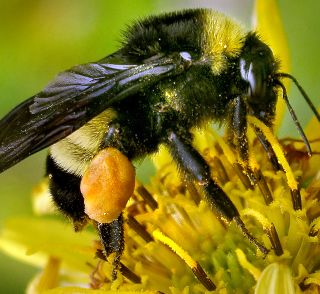 female American Bumble Bee |
Corbiculae
Bees are the number one insect pollinators of flowers due to the happy circumstance that their babies, called grubs, feast on pollen and nectar. Not only do bees visit many flowers but they are also fuzzy, picking up and dropping extra pollen in their travels, ensuring the exchange of genetic material between individual plants. There are a number of ways that female bees (the males do not help with this chore) can carry quantities of pollen back to their nests. A few unusual bees actually swallow it and store it in a crop. They later regurgitate the food for the young. Yes, it sounds a lot like birds! Most bees, though, transport the pollen with special brushes of hair called scopa, located on their hind legs. One family of bees, Megachilidae, carries the pollen on hairs under the abdomen, giving the bees a rather pot-bellied look. Two of our most common and economically important bees, the Bumble Bee and the Honey Bee, have yet another method of airlifting their load. A special depression surrounded by stiff hairs on each rear leg forms a corbicula, or pollen basket. The bee presses pollen and nectar into this structure and, like a gob of damp flour, it stays put. Once there is a good amount of pollen on the corbicula, it is sort of difficult to see the underlying anatomical feature, but it is there, holding the glob securely enough that the bee doesn't lose it while flying or crawling around.
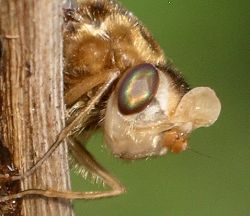 injured Horse Stomach Bot Fly |
Ptilinum
Flies seem to have a plethora of strange modifications to the basic insect body plan and the ptilinum is a particularly odd one. Insects that form a cocoon or hard casing (a puparium) around their pupa need to have a way to break out once they have completed their metamorphosis and are ready to emerge as adults (there is even a word for this: eclose). It's sort of like a bird or reptile breaking out of its eggshell. For some flies, the puparium, which protected the vulnerable pupa, must be split or otherwise opened so the soft-bodied adult can escape. The ptilinum is a membranous sac in the fly's face that everts and helps with this task. A newly emerged (teneral) fly often has a swollen looking head as the ptilinum hasn't yet collapsed back into the slit where it resides. As the fly dries out and its exoskeleton hardens, all outward signs of the ptilinum disappear; it has served its purpose and that's that. One thing that seems to be capable of deploying the ptilinum on a fully active adult fly is trauma. Yes, it seems that there is a biological version of the automobile airbag. The bot fly shown in the illustration was circling and laying eggs on the legs of a horse. The owners managed to whack the pest with a fly swatter, which stopped it from flying but didn't actually kill it. By the time I saw the injured insect, it couldn't fly very well but was walking around and still had the normally hidden ptilinum sticking out of its face. Strange but true.
Humans like to name things, including our own body parts. We call our back teeth molars and the front ones incisors. Ear lobes, eye lashes and lips are details of our anatomy we felt compelled to label. We have thumbs, a navel, and a uvula. With three major segments, as well as numerous subparts, the complex anatomical forms of insects certainly lend themselves to the naming of their many fascinating and unique structures. People are exceptionally curious and love to discover, examine and understand everything we find. And so we invented the labels. Homo sapiens are the only creatures on Earth with brains complex enough to create terms for every observable body element, both for our species and our fellow inhabitants upon this delightfully complicated life infested world.